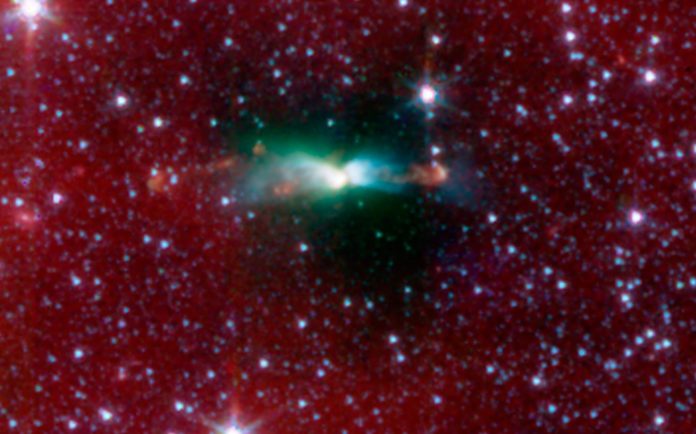Star-forming cloud L483 appears typical in a zoomed-out, distant perspective but things got crazier and weirder when a team of astrophysicists zeroed in closer and closer.
The iconic scene from “Star Wars,” in which Luke Skywalker wistfully gazes up at the twin stars that his home planet Tatooine orbits, is well-known to most people. Scientists now know that this situation isn’t just science fiction; planets around binary stars might potentially be habitable.
From a far distance, star-forming cloud L483 looks like a normal cloud. But as an astrophysics team led by Northwestern University zoomed in closer and closer, things became increasingly bizarre.
The researchers noted that the cloud’s magnetic field was strangely distorted when they got closer to it. Then they noticed a hidden star buried behind a newborn star within the cloud when they inspected it.
Erin Cox of Northwestern University, who conducted the latest study, described it as “basically the star’s sibling.” “We think these stars formed far apart, and one moved closer to the other to form a binary. When the star traveled closer to its sibling, it shifted the dynamics of the cloud to twist its magnetic field.”
The new information helps us understand how binary stars form and how magnetic fields affect the early stages of star growth.
Cox will discuss his findings at the American Astronomical Society’s (AAS) 240th conference in Pasadena, California. The study will also be published in the Astrophysical Journal next week.
Strange mystery
Stellar nurseries are untamed and fantastical places. When thick clouds of gas and dust collapse to become stars, they generate supersonic outflows of stellar material. The magnetic field that surrounds a star-forming cloud is usually parallel to these outflows. Cox and her colleagues noticed this when they looked at the large-scale L483 cloud. This was the magnetic field’s typical profile.
However, when astrophysicists used NASA’s Stratospheric Observatory for Infrared Astronomy (SOFIA) to take a closer look, things started to get weird. The magnetic field was not parallel to the outflows of the young stars. Instead, with regard to the outflows, the field was twisted at a 45-degree angle.
“At first, it matched what theory predicts,” remarked Cox. “If you have a magnetized collapse, then the magnetic field is controlling how the star is forming. We expect to see this parallelism. But theory can say one thing, and observations can say another .”
Atypical binary formation
Although further investigations are needed, Cox argues the twisted field is caused by a previously unseen twin star. The astrophysics team used SOFIA to find one young star forming inside a material envelope. However, when the researchers used radio telescopes at the Atacama Large Millimeter/submillimeter Array (ALMA) in Chile to look closer, they discovered a second star that shared the same stellar envelope.
As explained by Cox, “These stars are still young and still forming. The stellar envelope is what supplies the material to form the stars. It’s similar to rolling a snowball in snow to make it bigger and bigger. The young stars are ‘rolling’ in material to build up mass.”
The two young stars form a binary system about the same distance apart as our sun and Pluto. Astrophysicists currently agree that binaries can arise when star-forming clouds are massive enough to produce two stars, or when the disc orbiting around a young star partially collapses to produce a second star.
However, Cox feels something unique is going on with the twin stars in L483.
“There is newer work that suggests it’s possible to have two stars form faraway from each other, and then one star moves in closer to form a binary,” Cox added. “We think that’s what is happening here. We don’t know why one star would move toward another one, but we think the moving star shifted the dynamics of the system to twist the magnetic field .”
Cox hopes that this new research will eventually lead to a new understanding of how binary stars — and the planets that orbit them — emerge. The iconic scene from “Star Wars,” in which Luke Skywalker wistfully gazes up at the twin stars that his home planet Tatooine orbits, is well-known to most people. Scientists now know that this situation isn’t just science fiction; planets around binary stars might potentially be habitable.
“Learning how binary stars form is exciting because the planet and star formation take place at the same time, and binary stars dynamically interact with each other,” added Cox. “In our census of exoplanets, we know planets exist around these double stars, but we don’t know much about how these planets differ from the ones that live around isolated stars. With new instruments coming online to discover and probe new binary systems, we will be able to test these results with a statistical sample.”
Image Credit: NASA/JPL-CALTECH/J.TOBIN (UNIVERSITY OF MICHIGAN)
You were reading: New Evidence That Wandering Stars Can Form Binary Systems
